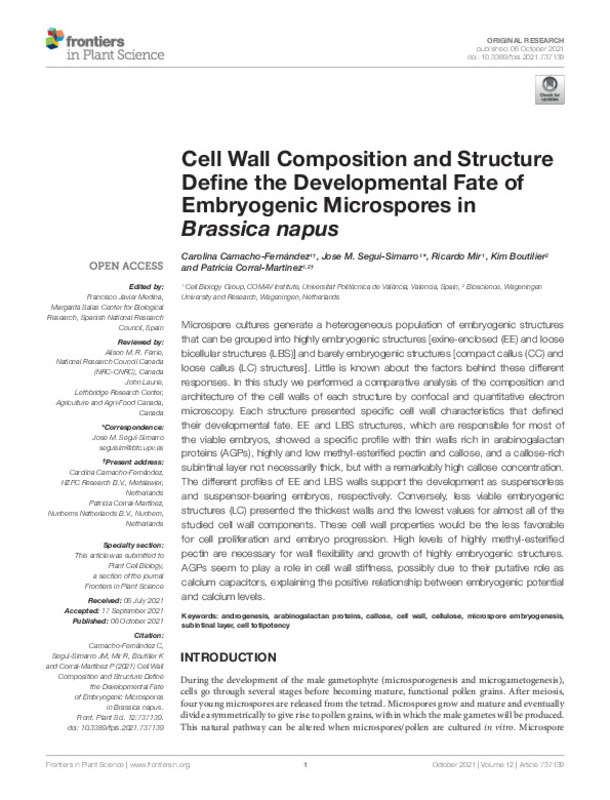JavaScript is disabled for your browser. Some features of this site may not work without it.
Buscar en RiuNet
Listar
Mi cuenta
Estadísticas
Ayuda RiuNet
Admin. UPV
Cell Wall Composition and Structure Define the Developmental Fate of Embryogenic Microspores in Brassica napus
Mostrar el registro sencillo del ítem
Ficheros en el ítem
| dc.contributor.author | Camacho-Fernández, Carolina
|
es_ES |
| dc.contributor.author | Seguí-Simarro, Jose M.
|
es_ES |
| dc.contributor.author | Mir Moreno, Ricardo
|
es_ES |
| dc.contributor.author | Boutilier, Kim
|
es_ES |
| dc.contributor.author | Corral-Martínez, Patricia
|
es_ES |
| dc.date.accessioned | 2022-10-06T18:05:42Z | |
| dc.date.available | 2022-10-06T18:05:42Z | |
| dc.date.issued | 2021-10-06 | es_ES |
| dc.identifier.uri | http://hdl.handle.net/10251/187192 | |
| dc.description.abstract | [EN] Microspore cultures generate a heterogeneous population of embryogenic structures that can be grouped into highly embryogenic structures [exine-enclosed (EE) and loose bicellular structures (LBS)] and barely embryogenic structures [compact callus (CC) and loose callus (LC) structures]. Little is known about the factors behind these different responses. In this study we performed a comparative analysis of the composition and architecture of the cell walls of each structure by confocal and quantitative electron microscopy. Each structure presented specific cell wall characteristics that defined their developmental fate. EE and LBS structures, which are responsible for most of the viable embryos, showed a specific profile with thin walls rich in arabinogalactan proteins (AGPs), highly and low methyl-esterified pectin and callose, and a callose-rich subintinal layer not necessarily thick, but with a remarkably high callose concentration. The different profiles of EE and LBS walls support the development as suspensorless and suspensor-bearing embryos, respectively. Conversely, less viable embryogenic structures (LC) presented the thickest walls and the lowest values for almost all of the studied cell wall components. These cell wall properties would be the less favorable for cell proliferation and embryo progression. High levels of highly methyl-esterified pectin are necessary for wall flexibility and growth of highly embryogenic structures. AGPs seem to play a role in cell wall stiffness, possibly due to their putative role as calcium capacitors, explaining the positive relationship between embryogenic potential and calcium levels. | es_ES |
| dc.description.sponsorship | This work was supported by grant PID2020-115763RBI00 to JS-S from Spanish MICINN and by a Juan de la Cierva -Incorporacion Fellowship and a Marie Sklodowska-Curie Individual Fellowship (656579) to PC-M. RM holds a CDEIGENT (2018/023) fellowship from Generalitat Valenciana. | es_ES |
| dc.language | Inglés | es_ES |
| dc.publisher | Frontiers Media SA | es_ES |
| dc.relation.ispartof | Frontiers in Plant Science | es_ES |
| dc.rights | Reconocimiento (by) | es_ES |
| dc.subject | Androgenesis | es_ES |
| dc.subject | Arabinogalactan proteins | es_ES |
| dc.subject | Callose | es_ES |
| dc.subject | Cell wall | es_ES |
| dc.subject | Cellulose | es_ES |
| dc.subject | Microspore embryogenesis, Subintinal layer, Cell totipotency | es_ES |
| dc.subject.classification | GENETICA | es_ES |
| dc.subject.classification | BIOLOGIA CELULAR | es_ES |
| dc.title | Cell Wall Composition and Structure Define the Developmental Fate of Embryogenic Microspores in Brassica napus | es_ES |
| dc.type | Artículo | es_ES |
| dc.identifier.doi | 10.3389/fpls.2021.737139 | es_ES |
| dc.relation.projectID | info:eu-repo/grantAgreement/AEI/Plan Estatal de Investigación Científica y Técnica y de Innovación 2017-2020/PID2020-115763RB-I00/ES/ESTUDIO DEL PAPEL DEL CALCIO EN LA INDUCCION DE EMBRIOGENESIS IN VITRO EN ESPECIES VEGETALES MODELO Y RECALCITRANTES/ | es_ES |
| dc.relation.projectID | info:eu-repo/grantAgreement/AGENCIA ESTATAL DE INVESTIGACION//IJCI-2016-27434//JUAN DE LA CIERVA INCORPORACION-CORRAL MARTINEZ/ | es_ES |
| dc.relation.projectID | info:eu-repo/grantAgreement/GENERALITAT VALENCIANA//CDEIGENT%2F2018%2F023//AYUDA CDEIGENT CONTRATACION RICARDO MIR MORENO/ | es_ES |
| dc.relation.projectID | info:eu-repo/grantAgreement/EC/H2020/656579/EU | es_ES |
| dc.rights.accessRights | Abierto | es_ES |
| dc.contributor.affiliation | Universitat Politècnica de València. Departamento de Biotecnología - Departament de Biotecnologia | es_ES |
| dc.contributor.affiliation | Universitat Politècnica de València. Instituto Universitario de Conservación y Mejora de la Agrodiversidad Valenciana - Institut Universitari de Conservació i Millora de l'Agrodiversitat Valenciana | es_ES |
| dc.description.bibliographicCitation | Camacho-Fernández, C.; Seguí-Simarro, JM.; Mir Moreno, R.; Boutilier, K.; Corral-Martínez, P. (2021). Cell Wall Composition and Structure Define the Developmental Fate of Embryogenic Microspores in Brassica napus. Frontiers in Plant Science. 12:1-16. https://doi.org/10.3389/fpls.2021.737139 | es_ES |
| dc.description.accrualMethod | S | es_ES |
| dc.relation.publisherversion | https://doi.org/10.3389/fpls.2021.737139 | es_ES |
| dc.description.upvformatpinicio | 1 | es_ES |
| dc.description.upvformatpfin | 16 | es_ES |
| dc.type.version | info:eu-repo/semantics/publishedVersion | es_ES |
| dc.description.volume | 12 | es_ES |
| dc.identifier.eissn | 1664-462X | es_ES |
| dc.identifier.pmid | 34691114 | es_ES |
| dc.identifier.pmcid | PMC8526864 | es_ES |
| dc.relation.pasarela | S\449353 | es_ES |
| dc.contributor.funder | European Commission | es_ES |
| dc.contributor.funder | GENERALITAT VALENCIANA | es_ES |
| dc.contributor.funder | AGENCIA ESTATAL DE INVESTIGACION | es_ES |
| upv.costeAPC | 3630 | es_ES |








